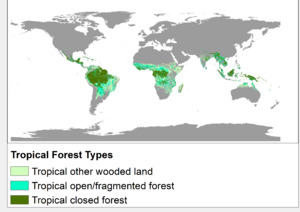Tropical forest facts for kids
Tropical forests are amazing places full of trees and plants that grow in warm parts of the world. You might also hear them called jungles! These forests are mostly found in areas between the tropic of Cancer and Capricorn. Think of them as Earth's green belts near the equator.

It can be tricky to count exactly how many tropical forests there are. This is because different people define what a "forest" is in slightly different ways. Even so, we know that tropical forests cover a huge part of our planet. They make up almost half of all the forests in the world!
Sadly, a lot of these special forests are disappearing. For example, in 2018, over 3.6 million hectares of untouched tropical forest were lost. That's a very big area!
Contents
How Tropical Forests Began
The first tropical rainforests were among the earliest types of plant life on Earth. They covered large parts of the planet's land. About 40 million years ago, during a time called the Paleogene epoch, other types of forests started to grow. These spread north and south of the equator as the climate became a bit drier and cooler.
Scientists officially recognized tropical forests as a special type of natural area, or "biome," in 1949.
Different Kinds of Tropical Forests
When you think of tropical forests, you might picture lush, green evergreen rainforests. While these are a big part of it, tropical forests are actually much more diverse! There are many other types, including:
- Eucalyptus open forests
- Tropical coniferous forests (with cone-bearing trees)
- Savanna woodlands, like those in the Sahel region
- Mountain forests, which at higher elevations can become cool, misty cloud forests
Sometimes, it's hard to tell exactly where one type of forest ends and another begins. They can blend into each other!
What makes a tropical forest look the way it does depends on several things:
- Where it is: This includes its location and climatic zone.
- Temperature: Near the equator, temperatures stay pretty much the same all year. Further away, there might be a cooler season.
- Rainfall: How much rain falls and when it falls is very important. Strong dry seasons can change the types of plants that grow there.
- Elevation: How high up a forest is can create unique "ecological islands." These are places where special plants and animals live that are found nowhere else. A good example is Mount Kinabalu in the Borneo rainforest.
- Its past: How old the forest is and if it has been disturbed recently matters. An old, untouched forest usually has the most different kinds of plants and animals. If a forest has been cut down or farmed, it becomes a secondary forest.
- The soil: The type of soil also affects what can grow. Things like how deep the soil is and how well water drains through it are important.
Global Forest Types
The World Wildlife Fund (WWF) has a plan called the Global 200. It groups tropical and subtropical areas into three main forest types:
- Tropical and subtropical coniferous forests (forests with cone-bearing trees).
- Tropical and subtropical dry broadleaf forests (forests with wide leaves that have a dry season).
- Tropical and subtropical moist broadleaf forests (forests with wide leaves that get a lot of rain).
Extent of tropical and sub-tropical -
Dangers to Tropical Forests
Tropical forests face many threats, even those that are special High-Biodiversity Wilderness Areas. These dangers include losing their homes (habitat loss) and changes to the climate caused by humans.
Studies show that climate change is making extreme weather events worse. Things like droughts, heatwaves, and hurricanes are happening more often and are more intense. When these events combine with human activities, they cause serious harm to tropical forests worldwide.
Many forests are being cut down to make room for farms or to get resources. For example, in parts of South America, Africa, and Southeast Asia, forests are cleared to produce things like beef, soy, coffee, palm oil, and wood. To help stop this, we need better ways to track where products come from. We also need more teamwork between governments and businesses.
A study in Borneo showed that between 1973 and 2018, the amount of old-growth forest (very old, untouched forest) on the island dropped from 76% to 50%. This was mostly due to fires and expanding farms. Many people believe that if we put a value on the helpful things these forests provide, like clean air and water, it could lead to better ways to protect them.
See also
 In Spanish: Bosque tropical para niños
In Spanish: Bosque tropical para niños
- Tropical rainforest
- Gallery forest
- Savanna
- Seasonal tropical forest
- Primary forest
- Secondary forest







